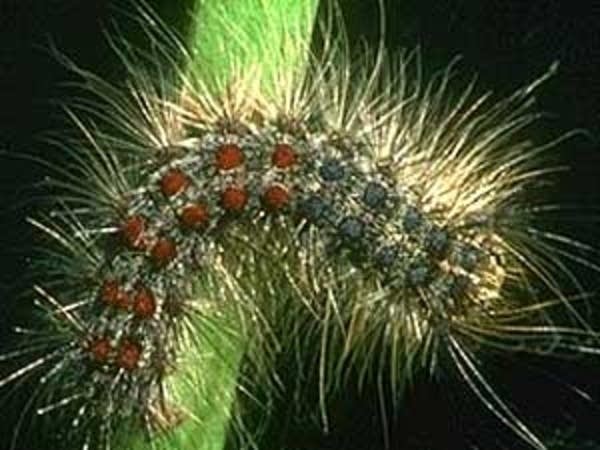Gypsy moth control efforts set to resume in Minnesota
Go Deeper.
Create an account or log in to save stories.
Like this?
Thanks for liking this story! We have added it to a list of your favorite stories.

Update: May 16, 8:30 p.m.
Efforts to slow the spread of invasive, tree-damaging gypsy moths in Minnesota will soon resume for the season in 13 targeted areas in the eastern part of the state.
Gypsy moths were introduced to the East Coast from Europe in the 1800s and have been slowly spreading westward ever since. The don't have a lot of natural predators, and gypsy moth caterpillars can defoliate trees in the middle of summer.
Minnesota is on the front lines of the battle against the insects, and the state is part of a national program to limit how quickly the moths spread.
"Our goal is to reduce populations before they get established — to kind of suppress them, knock them out, slow them down from moving westward into our state," said Kimberly Thielen Cremers, Plant Pest Regulatory and Mitigation Section manager at the Minnesota Department of Agriculture. "It's been a very successful program. Together, we've been able to reduce that natural spread by over 60 percent."
Turn Up Your Support
MPR News helps you turn down the noise and build shared understanding. Turn up your support for this public resource and keep trusted journalism accessible to all.
Control efforts can include low-flying aircraft early in the morning, spreading a biological, organic insecticide that's targeted at gypsy moth caterpillars. They also spread pheromones that don't kill anything, but instead confuse male moths and disrupt mating.

Treatment target areas are determined by findings from more than 20,000 gypsy moth traps set each year — you may have seen them tied to trees in parks and yards in eastern Minnesota.
“Those give us an indication of where high populations are starting to become apparent,” Thielen Cremers said. “And that's where we do management.”
This year's target areas for treatment include along the North Shore from eastern Duluth to beyond Two Harbors, and from the far western Duluth suburbs southwest toward Jay Cooke State Park.
A small section of Minneapolis near Loring Park also is included, along with parts of Houston, Wabasha and Winona counties. In total, about 136,000 acres are slated for treatment statewide.
The Department of Agriculture said the treatments near Loring Park may begin as early as Monday, May 17. When spraying begins, crews will be out as early as 5 a.m. over several days. While most treatments involve aerial spraying, the treatments near Loring Park will be done from the ground.
Other southern target areas will be treated starting in mid-May; northern areas starting in early June. Exact treatment dates depend on weather conditions, and when caterpillars emerge.
"Every resident in those target areas should have received a postcard notification in their mailboxes, giving them notice about the project," Thielen Cremers said. People can also go to the MDA website and type in their address to see if their home is in a target area, and sign up for text alerts when treatments are set to take place.
“We will notify you of the exact date on which we're going to do our operation,” Thielen Cremers said. “So it's a really wonderful tool for those folks that want to know ‘when will an aircraft be in the air?’ ‘When will they be out of the air?’ ”



